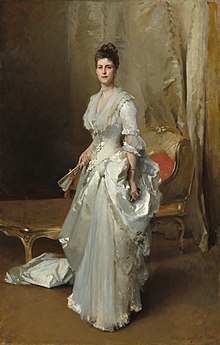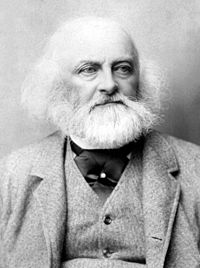astro.wikisort.org - Researcher
Lewis Morris Rutherfurd (November 25, 1816 – May 30, 1892) was an American lawyer and astronomer, and a pioneering astrophotographer.[1][2]
Early life and work
Rutherfurd was born in Morrisania, New York to Robert Walter Rutherfurd (1788–1852) and Sabina Morris (1789–1857) of Morrisania. He was the grandson of U.S. Senator John Rutherfurd from 1791 to 1798,[2] and great-grandson of Lewis Morris, the Signer of the Declaration of Independence.[3] Major General William Alexander, the Earl of Stirling, was the uncle of his grandfather.[4]
He graduated from Williams College, Massachusetts in 1834.[5]
Career

Soon after graduating from Williams, he began practicing law after being admitted to the bar in 1837 with William H. Seward, who eventually served as the United States Secretary of State, in Auburn, New York. In practicing, he associated with Peter A. Jay, the eldest son of the first United States Chief Justice, John Jay, until his death in 1843.[2] At that point, he began working with Hamilton Fish, who also became a U.S. Senator and the U.S. Secretary of State.[5]
Astronomy and astrophotography
In 1849, Rutherfurd abandoned his study of law to dedicate his leisure to science, particularly astronomy. He performed pioneering work in spectral analysis, and experimented with celestial photography. He invented instruments for his studies, including the micrometer for measuring photographs, a machine for producing improved ruled diffraction gratings, and the first telescope designed specifically for astrophotography.[4]
Using his instrumentation, Rutherfurd produced a quality collection of photographs of the Sun, Moon, and planets, as well as star clusters and stars down to the fifth magnitude. In 1862, he began making spectroscopic studies using his new diffraction grating. He noticed distinct categories of spectral classes of stars, which Angelo Secchi expanded upon in 1867 to list a set of four stellar classes.[6]
Rutherfurd served as a trustee of the Columbia University from 1858 until 1884, and donated his photographs to that institution.[4]
In 1873, then President Ulysses S. Grant appointed Rutherfurd one of the scientific commission to attend the Vienna Exposition, however, he declined the honor due to previous business engagements in the United States. In 1884, he was named by President Chester A. Arthur as one of the delegates to the International Meridian Conference which met in Washington in October, 1885.[2]
He was one of the original members of the National Academy of Sciences created in 1863, and was an associate of the Royal Astronomical Society.[2]
Personal life


On July 22, 1841, he married Margaret Stuyvesant Chanler (1820–1890),[1] the daughter of the Rev. Dr. John White Chanler, an Episcopalian clergyman, and Elizabeth Shirreff Winthrop. Margaret's brother John Winthrop Chanler (1826–1877) was a U.S. Representative, and her mother was a 2x great-granddaughter of Wait Winthrop and Joseph Dudley, both prominent colonial American figures. She was also the niece, and adopted daughter, of Helena (nee Rutherfurd) Stuyvesant and Peter Gerard Stuyvesant (1778–1847),[7] the 2x great-grandson of Peter Stuyvesant, the last Dutch Director-General of New Netherland before it became New York,[8][9][10][11] Together, they were the parents of:[4]
- Rutherfurd Stuyvesant (1843–1909),[11][12] who was married to Mary Rutherfurd Pierrepont (1842–1879).[13][14][15] a granddaughter of Peter Augustus Jay.[3] After her death, he married Countess Mathilde Elizabeth Loewenguth de Wassanaer (1877–1948)[16] the widow of a Dutch Count.[17]
- Helen Rutherfurd (1844–1845), who died young.[4]
- Elizabeth Winthrop Rutherfurd (1847–1847), who died young.[4]
- Margaret Stuyvesant Rutherfurd (1853–1916), who was married to Henry White (1850–1927), the U.S. Ambassador to France and Italy.[18]
- Louisa Morris Rutherfurd (1855–1892)[4]
- Lewis Morris Rutherfurd Jr. (1859–1901), who was married to Anne Harriman Vanderbilt (1861–1940).[19]
- Winthrop Chanler Rutherfurd (1862–1944),[20] who married Alice Morton (1879–1917), a daughter of former U.S. Vice President Levi Parsons Morton and Anna Livingston Reade Street.[21] After her death, he married Lucy Mercer,[22] a mistress of Franklin D. Roosevelt.[23]
In 1887, his health began to fail. Rutherfurd died on May 30, 1892 at his home, Tranquility, New Jersey.[1]
Awards and honors
Richard Proctor, the greatest popularizer of astronomy in the nineteenth century, called Rutherfurd "the greatest lunar photographer of the age."
- The lunar crater Rutherfurd is named after him.
- A professorship in Columbia University's astronomy department is named in his honor, as is the astronomical observatory atop Columbia's Pupin Hall.
- He was made an associate of the Royal Astronomical Society of London[2]
- He was made a Doctor of Law at the centennial celebration of Columbia in 1887.[2]
References
- Notes
- "Lewis Morris Rutherfurd" (PDF). New York Times. June 1, 1892. Retrieved January 9, 2014.
Lewis Morris Kutherfurd died on Decoration Day at his home, Tranquility, N.J., in the seventy-sixth [sic] year of his age.
- Rees, John K. (August 25, 1892). "Lewis Morris Rutherfurd". todayinsci.com. Columbia College Observatory. Retrieved July 21, 2017.
- Bergen, Tunis Garret (1915). Genealogies of the State of New York: A Record of the Achievements of Her People in the Making of a Commonwealth and the Founding of a Nation. Lewis Historical Publishing Company. p. 768. Retrieved July 14, 2017.
- Reynolds, Cuyler (1914). Genealogical and Family History of Southern New York and the Hudson River Valley: A Record of the Achievements of Her People in the Making of a Commonwealth and the Building of a Nation. Lewis Historical Publishing Company. p. 1232. Retrieved July 21, 2017.
- Devons, Samuel (July 1976). "Lewis Morris Rutherfurd | 1816-1892 | Vol. 15 No. 7" (PDF). physics.columbia.edu. Columbia University. Retrieved July 21, 2017.
- "Lewis Morris Rutherfurd | American astrophysicist". britannica.com. Encyclopedia Britannica. Retrieved July 21, 2017.
- Hughes, Stefan (2012). Catchers of the Light: The Forgotten Lives of the Men and Women Who First Photographed the Heavens. ArtDeCiel Publishing. ISBN 9781620509616. Retrieved July 18, 2017.
- Vanderbilt 1991, p. 152.
- Greene, Richard Henry; Stiles, Henry Reed; Dwight, Melatiah Everett; Morrison, George Austin; Mott, Hopper Striker; Totten, John Reynolds; Pitman, Harold Minot; Ditmas, Charles Andrew; Forest, Louis Effingham De; Maynard, Arthur S.; Mann, Conklin (1880). The New York Genealogical and Biographical Record. New York Genealogical and Biographical Society. p. 160. Retrieved July 18, 2017.
- "Peter Gerard Stuyvesant (1778-1847)". www.nyhistory.org. New-York Historical Society. Retrieved July 18, 2017.
- Rutherfurd, Livingston (1894). Family Records and Events: Compiled Principally from the Original Manuscripts in the Rutherfurd Collection. De Vinne Press. p. 252. Retrieved July 18, 2017.
- Stuyvesant Rutherfurd later changed his name to Rutherfurd Stuyvesant in conformity with the will of his mother's great-uncle, Peter Gerard Stuyvesant in order to inherit the Stuyvesant fortune.
- "H.E. PIERREPONT'S FUNERAL". The New York Times. April 1, 1888. Retrieved July 14, 2017.
- "HENRY E. PIERREPONT DEAD.; Retired Merchant Was One of the Brooklyn Family of Pierreponts". The New York Times. November 5, 1911. Retrieved July 14, 2017.
- "MRS. A. M. PIERREPONT DEAD.; Was a Granddaughter of John Jay, First Chief Justice of the United States Supreme Court". The New York Times. January 3, 1902. Retrieved July 14, 2017.
- "RUTHERFORD STUYVESANT MARRIED IN LONDON.; He Weds the Comtesse de Warranaer -- Ambassador Choate Present at the Ceremony". The New York Times. June 17, 1902. Retrieved July 19, 2017.
- "R. STUYVESANT DIES SUDDENLY IN PARIS; Stricken on Street -- Though Born Rutherfurd, an Ancestor Was Gov. Peter Stuyvesant. HE WAS 69 YEARS OLD Ambassador White's Brother-in-Law -- First Wife Was Miss Pierrepont -- Second, Countess de Wassenaer, Survives Him". The New York Times. July 5, 1909. Retrieved July 19, 2017.
- "HENRY WHITE, NOTED DIPLOMAT, 77, DEAD; Former Ambassador to France and Italy Succumbs to Operation in Lenox. SIGNED VERSAILLES TREATY At London Embassy 17 Years -- Funeral Tomorrow -- Ashes to Be Buried in Washington". The New York Times. July 16, 1927. Retrieved July 21, 2017.
- "W.K. VANDERBILT DIES IN FRANCE IN HIS 71ST YEAR; Was Eldest Male Survivor of Family That Built Fortune in New York Central. CHILDREN AT HIS BEDSIDE Duchess of Marlborough and Her Brothers Present with Financier's Widow. ESTATE NEAR $100,000,000 $300,000,000 Left by His Father in Eight Shares Believed to be Over Billion Total Now". The New York Times. July 23, 1920. Retrieved July 18, 2017.
- "W. RUTHERFURD, 82, LEADER IN SOCIETY; Sportsman, Member of Noted Family, Dies Was Owner of Famous Terrier Kennels". The New York Times. March 21, 1944. Retrieved July 18, 2017.
- "ENGAGEMENT OF MISS ALICE MORTON.; To Marry Winthrop Rutherfurd, One of the Best-Known Men in Society, an Adept at Out-Door Sports, and Wealthy". The New York Times. January 13, 1902. Retrieved July 18, 2017.
- "MRS. W. RUTHERFURD". The New York Times. August 1, 1948. Retrieved July 18, 2017.
- Persico, Joseph E. (2009). Franklin and Lucy: Mrs. Rutherfurd and the Other Remarkable Women in Roosevelt's Life. Random House Trade Paperbacks. p. 299. ISBN 9780812974966. Retrieved July 18, 2017.
- Sources
- Goodwin, Doris Kearns (1994). No Ordinary Time. Simon & Schuster. ISBN 9780684804484.
- Persico, Joseph E. (2008). Franklin & Lucy: President Roosevelt, Mrs. Rutherfurd, and the Other Remarkable Women in His Life. Random House. ISBN 9781400064427.
- Vanderbilt, Arthur T. (1991). Fortune's Children: The Fall of the House of Vanderbilt. HarperCollins. ISBN 9780688103866. Retrieved January 28, 2013.
External links
- Portraits of Lewis Morris Rutherfurd from the Lick Observatory Records Digital Archive, UC Santa Cruz Library's Digital Collections
- Guide to the Stuyvesant-Rutherfurd Papers, 1647-1917, The New York Historical Society
На других языках
[de] Lewis Morris Rutherfurd
Lewis Morris Rutherfurd (* 25. November 1816 in Morrisania, New York; † 30. Mai 1892 in Tranquility, New Jersey) war ein US-amerikanischer Astrophysiker. Er war ein Pionier in der Himmelsfotografie.- [en] Lewis Morris Rutherfurd
[ru] Резерфорд, Льюис Моррис
Льюис Моррис Резерфорд (в старой транскрипции Рутерфорд, англ. Lewis Morris Rutherfurd; 25 ноября 1816 (1816-11-25) — 30 мая 1892) — адвокат, владелец частной обсерватории около Нью-Йорка. Известен работами по астрофотографии.Другой контент может иметь иную лицензию. Перед использованием материалов сайта WikiSort.org внимательно изучите правила лицензирования конкретных элементов наполнения сайта.
WikiSort.org - проект по пересортировке и дополнению контента Википедии
